Toad lilies can be planted particularly well under trees and attract everyone's attention with their extraordinary flowers. We present the toad lily and its requirements in terms of location, fertilization and hibernation.
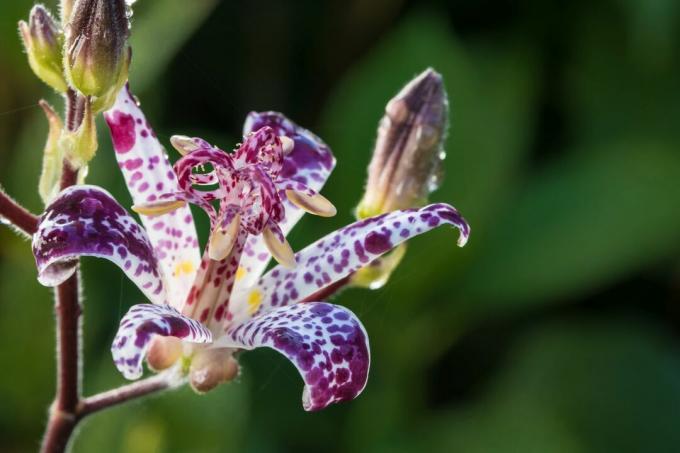
The toad lily (tricyrtis) is a delicate and graceful flowering plant for woodland gardens. The eye-catching, colorfully spotted flower is reminiscent of an orchid in structure, but is significantly less demanding and easy to care for. We present the toad lily and its most beautiful varieties and give tips on planting and caring for them tricyrtis.
contents
- Toad lily: characteristics and origin
- The most beautiful species and varieties of toad lily
- Planting toad lilies: location and procedure
- Care of the toad lily
- Are toad lilies hardy?
- Are toad lilies poisonous?
Toad lily: characteristics and origin
The toad lily, also known as the garden orchid or tiger star, belongs to the lily family (
Liliaceae). It is also rarely referred to as the tiger lily, but that is actually the species Lilium lancifolium. Originally from Asia Minor to East Asia, the toad lily grows wild from the Himalayas to Korea and on the islands of Japan and Taiwan. There are over 20 types of tricyrtis known, only a few of which have been cultivated.The perennial and hardy toad lily can reach a height of 20 to 80 cm depending on the species and variety. In contrast to many other lily plants, the toad lily does not form bulbs, but creeping rhizomes to survive. The ovate to elliptical, dark green leaves with clear veining are alternately attached to the thin, branched stems in the upper part.
From late summer between August and October, the toad lily begins to flower. The strikingly spotted, filigree flowers consist of six mostly white to yellow colored petals and six stamens. In the middle are also the three carpels, which have grown together to form an ovary and form three scars split like snake tongues on the outside. Rarely, bell-like flowers form from petals that have grown together and their shape resembles foxgloves (digitalis) remember as at Tricyrtis macrantha. The numerous spots on the petals also gave the toad lily its name, as it resembles the spotted skin of some toad species. Depending on the species, the flowers of the garden orchid are terminal or in the leaf axils in groups in a raceme or panicle. Bees and butterflies like to visit the flowers, which appear late in the year. After pollination, capsule fruits develop, inside which numerous, small, round seeds ripen.

The most beautiful species and varieties of toad lily
For the home garden, the wild forms of the toad lily (Tricyrtis macropoda), the yellow-flowered broad-leaved toad lily (Tricyrtis latifolia) and Tricyrtis macrantha, as well as different varieties of the Taiwanese toad lily (Tricyrtis formosana) and Japanese toad lily (Tricyrtis hirta), also called bristly toad lily. Many of the better known tricyrtisHowever, cultivars are hybrids of the Japanese toad lily and the Taiwanese toad lily. We present the most beautiful varieties of toad lilies for planting in your own garden.
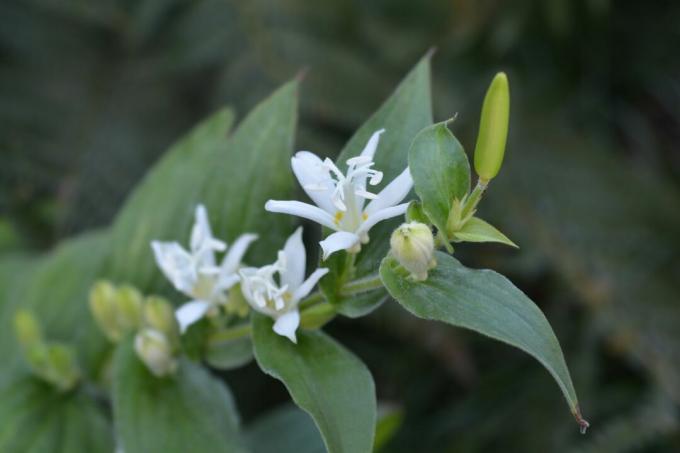
- 'Alba': Tricyrtis hirta-Variety with pure white flowers, each with a yellow spot at the base and a height of up to 50 cm. This rare color among toad lilies enchants with its numerous blooms between August and October.
- 'Blue Wonder': tricyrtis with an exceptional white flower color with large spots of brilliant blue-purple, while the stamens and ovary are speckled with red. The toad lily 'Blue Wonder' flowers from August and can reach a height of 50 - 60 cm.
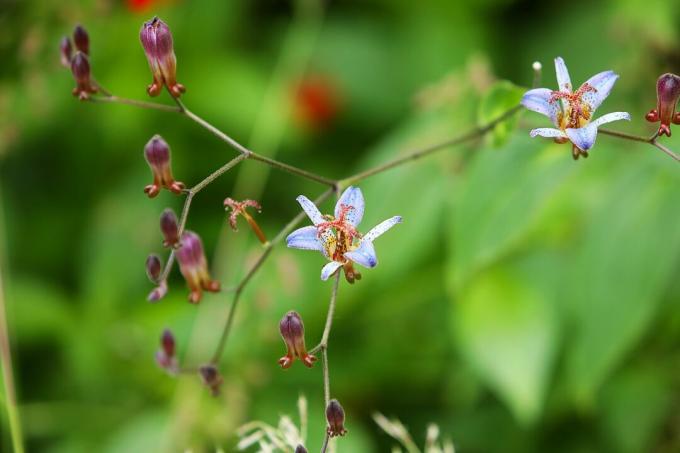
- 'Dark Beauty': Toad lily up to 70 cm tall and white flowers speckled with dark violet and red. The flowering time of the vigorous and runner-forming variety is between September and October.
- 'Miyazaki': The creamy white flowers of the Tricyrtis hirta 'Miyazaki' is covered with numerous purple-pink speckles and reaches a height of about 50 cm.
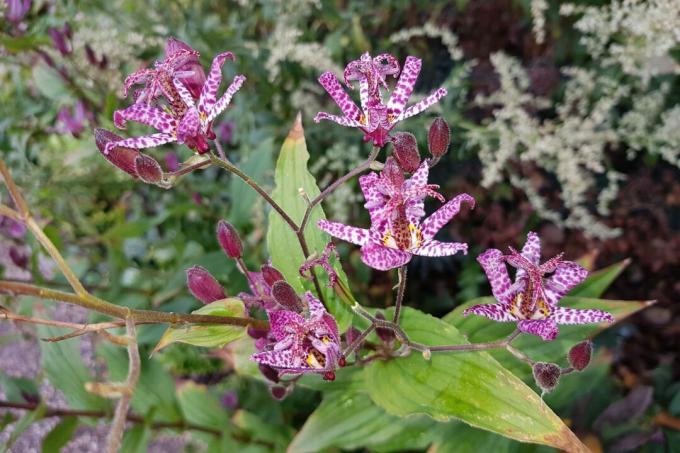
- 'Pink Freckles': Toad lily with soft rose to pink flowers and darker mottling. tricyrtis 'Pink Freckles' reaches a height of up to 30 cm and flowers between August and October.
- 'Raspberry Mousse': Particularly striking variety with burgundy petals and pale red stamens and carpels. The entire flower of the plant, which is up to 60 cm high, is finely mottled with pink to whitish and appears between September and October.
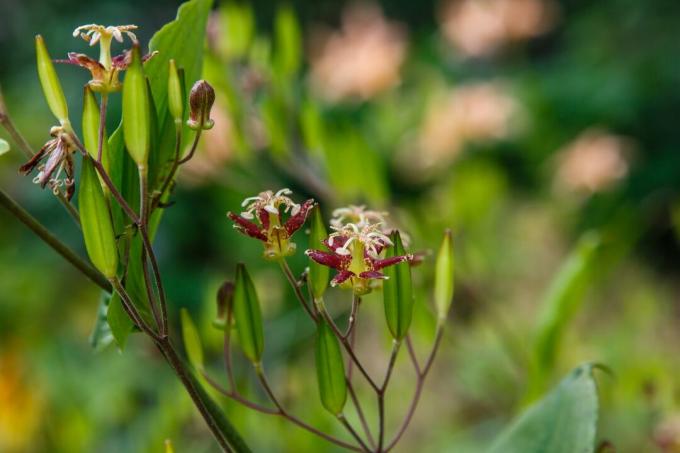
- 'sinonomials': tricyrtis- Hybrid with tall, strong plants up to 60 cm and late flowering from September. The white petals show conspicuous purple spots.
- 'Taiwan Adbane': Petite toad lily cultivar to 40 cm with pale purple speckled petals and yellow to pink stamen and carpels speckled with strawberry red.
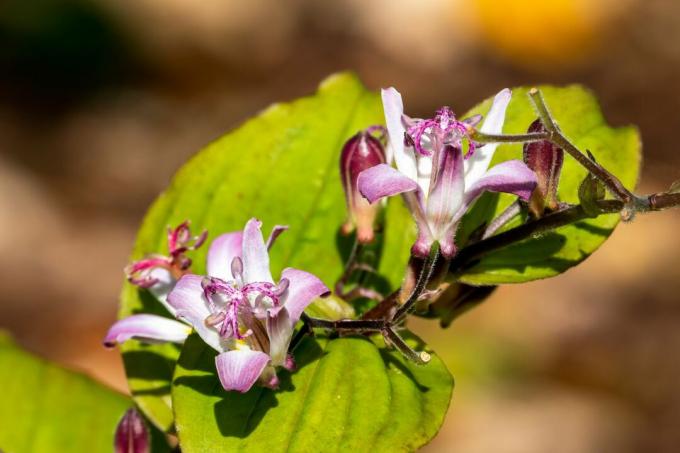
- 'Tojen': In this tall variety up to 80 cm, only the carpels are speckled in the middle, the petals are unicolored in soft pink to white with a decorative yellow spot at the base. The flowering period is between September and October.
- 'Variegata': toad lily with rather narrow, variegated leaves and pink speckled flowers. The striking variety can reach a height of up to 60 cm and flowers from August.
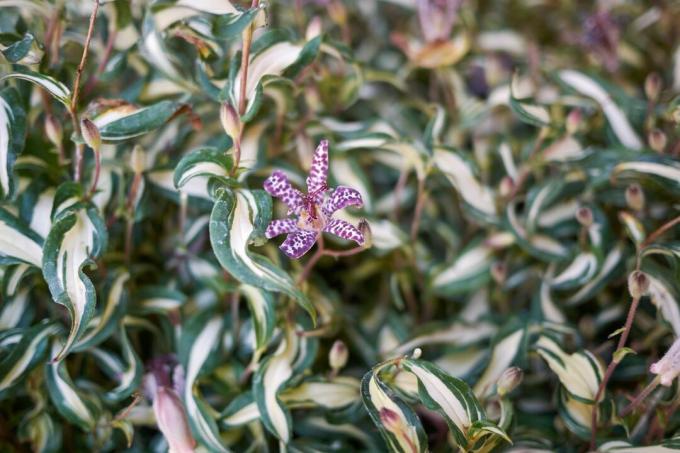
Planting toad lilies: location and procedure
The optimal location for toad lilies is in cool partial shade on humus-rich, moist and slightly acidic soil. It is therefore ideal as an underplanting for tall trees, in beds on the north side of the house and as an eye-catcher at the edge of the forest. The toad lily, on the other hand, does not tolerate waterlogged or calcareous substrates and full sun. Toad lilies should be planted in spring as they need some time to become established in a spot before the next winter arrives. Toad lilies are planted in small groups to ensure a sufficiently dense population. One calculates five to eight plants per square meter. The thick rhizomes with sprout buds are planted just as deep in the ground as they were in the pot before, otherwise rot can occur at the base of the sprout. A planting distance of 30 to 40 cm to other perennials should be maintained, with particularly vigorous and runner-producing varieties up to 60 cm are necessary.
The toad lily can be cultivated in a pot or in a bed. The planter should hold at least 5 to 10 liters of soil and have good drainage. The bottom 5 cm of the pot can be filled with a drainage layer of expanded clay, pebbles and sand to avoid waterlogging. A permeable, humus-rich substrate like ours is suitable for planting the toad lily in a tub Plantura organic potting soil fine. The pre-fertilized, peat-free substrate provides your toad lilies with all the necessary nutrients for a few weeks and, thanks to the high compost content, stores sufficient moisture. It can also be mixed with some acidic soil or mature compost to achieve the optimal pH for the soil tricyrtis to reach.
Good planting partners for toad lilies are other forest edge dwellers, such as ferns or grasses, the Japanese mountain grass (Hakonechloa macra) or hosts (hosta), elf flowers (epimedium), Solomon's Seal (polygonatum), cranesbill (geranium) and deadnettle (lamium).

Care of the toad lily
Toad lilies are easy to care for and undemanding in suitable locations. The dead stalks from the previous year are only removed in the spring, just before the new shoots. Fertilization is also carried out at this time to provide the garden orchid with sufficient nutrients for healthy growth and rich flowering in late summer and autumn. A predominantly organic long-term fertilizer, like ours Plantura organic flower fertilizer, releases the nutrients it contains slowly and gently for plants and the environment over a period of several weeks. The animal-free fertilizer granules are spread around the perennials and optimally worked in lightly on the surface. Then it should be watered. In summer, there is less re-fertilization, which is usually sufficient until the end of the season.
Snail feeding can be a problem at spring bud break. A snail fence, plant collar or, in the case of a high risk, slug pellets can help. The toad lily has a high water requirement - the soil should never dry out completely. Regular watering is one of the most important care measures on hot summer days. A mulch layer of grass clippings, bark or leaves reduces evaporation and keeps the soil moist for longer. Since nitrogen is bound when the mulch is broken down by the soil organisms, there may be an increased need for fertilizer.
tip: The fact that a toad lily does not bloom is usually due to a location that is too shady or soil that is too poor.

Are toad lilies hardy?
The toad lily is hardy to below -20 °C, which is why it hardly ever needs frost protection in our latitudes. A layer of foliage or mulch over the dormant bulbs is usually enough to overwinter the toad lily well. Toad lilies in tubs should, however, be overwintered frost-free if there is a risk that the roots and soil will freeze through. If the plants have already sprouted in the spring, they can suffer damage from late frost. In addition to a protected layer, a short-term covering with fleece or jute provides sufficient protection against particularly cold nights.
Are toad lilies poisonous?
Like most lily plants, toad lilies are poisonous and not suitable for consumption. All parts of the plant are poisonous and can lead to symptoms of poisoning such as nausea, headache, vomiting and drowsiness. Pets avoid the toad lily and usually do not even eat it.
A relative of the toad lily is the checkered flower (Fritillaria meleagris). Read with us which location the extraordinary onion plant prefers, how best to plant and care for it.



